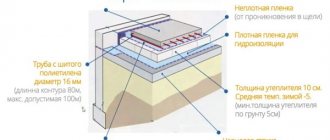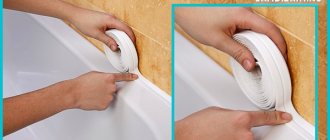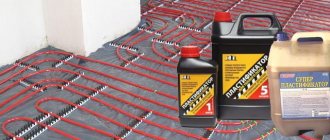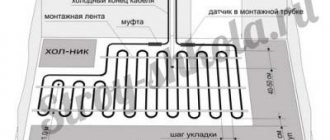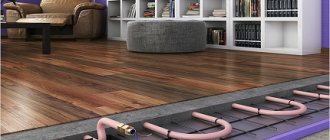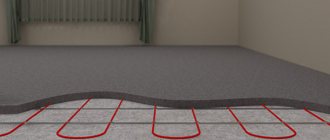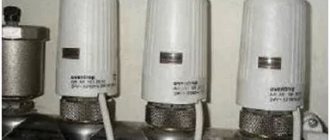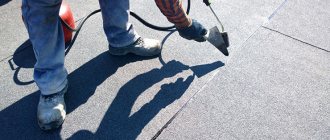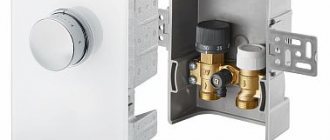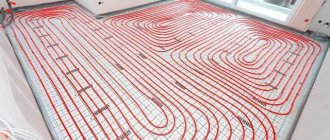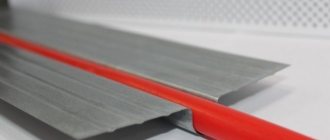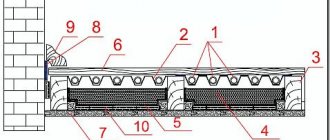Concrete floors without any “extension” can be considered the most reliable base for any finishing coating. A high-quality screed can serve for many decades without losing any of its operational capabilities. But the epithet “quality” in the previous sentence was not used by chance - the result could be completely different if the technology for laying the concrete floor was violated. If, whether by accident or deliberately, important nuances were ignored, which, to an amateur’s eye, may seem like mere trifles. One of these “little things” that directly affects the quality and durability of the screed is the use of a damper tape.
Damper tape - purpose, varieties, selection rules, review of popular brands
For all its simplicity and inconspicuousness, this element of the overall floor structure plays an important role in the long-term preservation of the integrity of the screed. Therefore, it sweetens the attention of a separate publication. So, as they say, “let’s get acquainted”: damper tape - purpose, varieties, selection rules, review of popular brands.
What is damper tape used for?
Damper tape (sometimes called compensating or edge tape) is a strip made of an elastic material of a polymeric nature. In addition, products on sale may differ in size (length, width and thickness), structure and purpose.
Installation of the compensation tape is clearly simple
Let's start with the materials - this simple but extremely necessary element of the screed system is made of dense elastic polymers, the performance characteristics of which, firstly, allow long-term contact with concrete (with its specific chemical environment), and secondly, retain volume and elasticity even under constant compressive loads.
Most often, foamed polyethylene is used to make expansion tapes. There are varieties made from densely woven polyester fibers (polyester) and from foamed synthetic rubber. Some craftsmen, when the necessary tape is not at hand, so as not to interrupt the process of pouring the floor, replace it with thin strips cut from extruded polystyrene foam (XPS) insulation boards.
All these materials, despite the significant difference in chemical formulas, have the properties that make it possible to use them as a damper tape:
- They are not afraid of moisture and do not absorb it. They do not create an environment favorable for the development of colonies of microflora (fungus, mold, etc.)
- A tape made from these materials does not change its characteristics under the influence of ultraviolet radiation (it must be said that there is not much of it here...), alkaline or acidic environment, or temperature fluctuations (within a reasonable range, of course, corresponding to operating standards).
- All of the listed materials, due to their air filling, tend to return to their original shape and volume after severe and prolonged compressive loads. That is, they straighten out like a spring.
- All these porous polymers are very light and easy to use. Therefore, to lay the edge tape it is not at all necessary to have any special knowledge and skills. Very often, its installation can be done even without additional materials.
Now let’s talk about what role the damper tape plays in the construction of a concrete floor.
Its main function becomes clear from one of the names - compensation tape. What does this mean?
Often, a whole network of cracks can be found on a concrete surface that is not laid completely correctly. They arise as a result of an increase in internal stresses due to thermal expansion of the material. That is, the screed layer simply has “nowhere to go” when expanding - it rests against hard walls, and its deformation may well begin with the appearance of cracks.
Thus, the coefficient of linear expansion of concrete is approximately equal to 0.00001 - this is the value (in meters) by which a concrete part one meter long will elongate when the temperature increases by 1 degree. It would seem like a completely insignificant quantity. But imagine, for example, fluctuations of 50 degrees (for an unheated room, this is quite a possible difference between winter and summer temperatures). This turns out to be 0.0005 meters, that is, half a millimeter. And if the room is, say, six meters long, the thermal expansion of the screed increases by three millimeters. And if the compensation gap was not provided, the appearance of cracks due to internal stresses is a matter of short time.
The screed was all covered with long and deep cracks. But this is the beginning of the further process of erosion of the concrete floor covering.
The damper tape, laid around the perimeter before pouring the floor, ensures free expansion of the screed, so when it is used, the integrity of the coating will be ensured. An elastic cushion a few millimeters thick created along the walls will be quite sufficient to set the compensation gap.
The edge tape, due to its characteristics, in addition to its main purpose, also performs other functions:
- Creation of a restrictive barrier in certain areas, a kind of “formwork” for the mortar when pouring the screed.
A type of damper tape, well suited for waterproofing corners along the lines where walls meet the floor
- Organization of an additional heat and waterproofing barrier along the edges of the screed, that is, at the lower corners - the most vulnerable areas.
- The word "damper" means "vibration absorber". Indeed, the damper tape well dampens vibration transmitted through building structures from some mechanism operating in the building (elevator drive or ventilation) or a powerful household appliance (washing machine, pumping station, etc.). Its role is also important in absorbing impact noise, which is also transmitted over considerable distances along the structural elements of the house.
- It often eliminates the need to level the walls from below - the tape is able to level out surface imperfections in the area that will be covered with a screed.
Damper tape is strongly recommended for use in the following cases:
- When laying a traditional leveling screed. Moreover, this also applies to “dry” technology, that is, using dry expanded clay backfill followed by laying a hard covering over it.
- When filling floors with self-leveling compounds on a mineral or organic basis.
Installation of a damper tape around the perimeter of the room between thermal insulation mats and walls - for subsequent filling of the created “warm floor” with screed.
- When installing a “warm floor” system (no matter water or electric), which will be covered with a layer of screed. Here, by the way, there is no way to do without a damper tape - temperature fluctuations in heated floors can be significantly higher than in conventional ones.
- When creating blind areas around the perimeter of the building - for the deformation gap between them and the base.
In rooms with a large area, laying a damper layer only around the perimeter of the room may not be enough. Expansion joints are also provided with a certain pitch, depending on the thickness of the screed. Such seams, of course, can be cut later, after the concrete has hardened, then filled with some kind of elastic material. But often this is foreseen in advance - a special T-shaped damper tape is installed in advance before pouring.
Advantages and disadvantages of damper tape
In the vast majority of cases, during repairs, craftsmen have to work with tape made of foamed polyethylene. This material copes well with the tasks outlined above:
- Foamed, that is, polyethylene consisting of closed cells filled with air, has a high degree of elasticity, due to which it easily takes the shape of surface imperfections and fits tightly to the wall.
- Even with very strong pressure on the tape, it is easily pressed and also easily restored.
Restoring the shape and volume of the material after exposure to external loads is the most important quality of foamed polyethylene
- Due to the high thermal insulation properties of polyethylene foam, the level of heat loss along the joints of floors and walls is significantly reduced.
- Absorption of impact noise and vibration is also an important factor;
- The material is environmentally friendly - polyethylene is completely “harmless”, that is, it will not emit any toxic compounds.
- The water resistance of the closed cellular structure of polyethylene foam allows the tape to be used as a waterproofing belt around the perimeter of the room, for example, when pouring floors in the bathroom or kitchen.
- The tape does not rot, does not rot, does not decompose, and is resistant to chemical “aggression”, that is, its service life is comparable to the service life of a concrete floor.
- Installation of the tape is simple and straightforward, takes a minimum of time and does not require any physical effort or special tools.
Disadvantages of the material? - it’s even difficult to single out something... All that comes to mind is that the tape becomes an additional line in the estimate for the work. Well, firstly, most brands of such products are still not intimidating with their cost. And secondly, given the functionality and positive characteristics of the tape, this conditional disadvantage seems absolutely insignificant.
Types of compensation tape and their features
Today, there are different types of compensation polymer layers on sale. This section will look at what they are and what they are used for.
| Illustration | Brief description of the material and its application |
| Standard version of compensation tape. It may vary in width and thickness. This layer is simply laid upright against the wall along the entire perimeter of the future screed. The material has the most affordable price of all types of tapes, but it is also the most inconvenient for installation, since the manufacturer does not provide for fastening to a vertical surface. If desired, the tape can be fixed with double-sided tape or polyurethane glue. Sometimes it is even pressed against the wall with piles of mortar or dry backfill. | |
| A self-adhesive type of damper tape - equipped with an adhesive strip, temporarily covered with a protective film, and which is removed immediately before laying the material against the wall. An easy-to-install option, it is well fixed to the wall, so during the pouring process the screed does not move and does not “lubricate” the edge of the slab. True, such a tape will stick well only to a flat and clean wall - otherwise there is no need to overpay, you can be content with the usual one. | |
| A ribbon equipped with a “skirt” (basque). This type of material is divided along its entire length into two parts - the main one, made of foamed polyethylene, and the “skirt”, consisting of ordinary dense polyethylene. The dense part of the tape is installed along the wall, and the “skirt” is laid on the floor. This way the joints between the wall and the floor are waterproofed. An excellent solution for preparing for pouring screed in the bathroom. A tape equipped with a peplum may have an adhesive layer or be left without it. | |
| The T-shaped version of the damper tape is used in cases where the screed has a large area, and the deformation gaps along the walls alone are not enough to compensate for the expansion of concrete. The installed T-shaped tape, after pouring and hardening of the screed, as is probably understandable, turns into a ready-made expansion joint. | |
| For ease of working with tape, some manufacturers make samples that have several cuts - tear lines along their entire length. When working with such a tape, it will not be a problem to remove the excess protruding upward after the screed is ready. However, cutting off the excess with a sharp knife doesn’t take long either. So the author of the article, for example, has doubts whether it is worth overpaying for such a bonus. |
There are probably no standardized forms of tape release - each manufacturer is free to use their own standards. We can only clarify that the following sizes are most often found:
- the thickness of the material usually varies from 3 to 10 mm;
- width - 80÷150 mm;
- tapes are sold in whole coils (rolls), 10, 15, 20, 30, 50 and 100 m long
The tape, which has a width of 150 mm, is usually used for prefabricated structures, for example, if a “warm floor” system or dry screed is installed. The material, 100 mm wide, is used for one- or two-layer screeds, including when leveling floors with self-leveling compounds.
For what purpose and where is it used?
This is a relatively new material, which is consumable and consists of tapes of different thicknesses and heights, made of elastic materials that easily compress under load and restore their shape in its absence. The raw material for production is foamed polyethylene, in closed cells of which there is air.
To understand how the tape works, you can do a simple experiment. If you squeeze it with your fingers, the air bubbles are flattened, the material becomes thinner, but returns to its original size when the pressure is released.
After which it becomes clear why the damper tape is needed. Its main function in the structure of a concrete floor is to compensate for the linear expansion of the screed, preventing its deformation in case of hard contact with the walls. As the slab expands, it presses not on the wall, but on an elastic gasket installed between them and filling the gap between the contacting planes.
Shock-absorbing tape when installing a floating screed Source i2.wp.com
However, the use of such a layer makes sense only if the screed is floating, that is, not connected to the base and mounted on waterproofing (waterproof film) or thermal insulation (insulation boards). If it is laid on a stable base and does not have a heating system, the damper will be useless.
But there are other tasks that can be achieved using this material. When deciding whether a damper tape is needed for a floor screed, you should also remember these:
- Compensation for periodic expansion of heated screeds from a heated floor system.
When the system is running, the plate expands in proportion to the heating force, and when it is turned off, it contracts. Periodically occurring pressure on the walls can ruin the external finish and cause stress and deformation in the structure itself.
On a note! When installing heated floors along external walls, it is better to install strips of insulation. This will not only compensate for temperature changes, but also reduce heat loss.
Diagram of a heated water floor Source pol-inform.ru
- Creating a gap between rooms with different thermal circuits.
In adjacent rooms, different temperatures of the heated floor are often set. Accordingly, it is necessary to arrange a thermal gap between them.
Such a compensator is mounted in a doorway Source eurosantehnik.ru
- Reduced vibration noise.
Another important point why damper tape is needed when screeding is to improve sound insulation between rooms. It dampens vibration and impact noise and prevents its transmission through supporting structures. This is especially true in high-rise buildings, townhouses and country houses with several apartments.
On a note! There is a special type of damper tapes - vibration damping tapes. They are made from rubber, caoutchouc, and other materials and are glued to metal profiles, which are the basis of the frame for interior partitions and wall cladding.
- Reduced cracking when fresh screed matures.
During the drying process, concrete loses moisture and “breaks” with the appearance of cracks. This problem is solved by reinforcing the screed and isolating it from the walls with an elastic gasket. It is laid around the perimeter, as well as in the body of the screed, if its linear dimensions on any side exceed 6-8 meters or the total area of the screed is more than 20 sq.m.
Separating the screed with a compression tape reduces the formation of shrinkage cracks Source chudopol.ru
- Construction of a technological gap between screed sectors poured at time intervals.
When a fresh screed comes into direct contact with a previously poured screed that has already gained strength, uncontrolled stresses arise that affect the strength of the coating. They are compensated by laying a buffer layer between adjacent sectors.
Summarizing the above, such a gasket must be done in the case of a floating screed or heated concrete screed. If we answer the question whether a damper tape is needed when pouring a self-leveling floor, then it will be positive only if there is a thick layer of leveling mixture or when it is installed on top of a heated floor. Simple thin-layer coatings up to 10 mm high do not need an edge around the perimeter of the walls.
When installing thin-layer self-leveling coatings, a buffer layer is not needed Source i.ytimg.com
All other cases are considered individually, the choice remains at the discretion of the home owner.
How to choose compensation tape?
Construction stores offer a large number of products from different manufacturers. The same type of tapes from different brands differ more in their appearance and price than in their characteristics. And in order to choose a high-quality material that will be able to perform all the functions mentioned above, you need to pay attention to some nuances:
If the product is sold in a package, you are less likely to purchase tape that is deformed or damaged during transportation
- Before purchasing a compensation tape, you need to decide on its width. In this case, the total thickness of the entire multi-layer floor structure being created must be taken into account. The tape should rise above the surface of the screed by 10÷15 mm.
- The tape is sold in rolls, and it is better if it is enclosed in a sealed factory packaging. You should pay attention to the integrity of the roll and the absence of deformations.
- If the tape is damaged, then even if it is discounted, you should not buy it, since this means that the normal conditions of its storage and transportation were grossly violated.
- There should be no contamination on the surface of the material.
Manufacturers often include in the attached product label not only the characteristics of the material, but also recommendations for installing the tape.
- It is necessary to pay attention to the density of the roll winding - so as not to buy a coil from which tens of meters have already been unwound.
- If you purchase a self-adhesive version of the tape, and even the slightest delamination is noticed in the roll, then it is possible that the glue is no longer suitable for use.
- It is worth giving preference to products manufactured by well-known companies that have been producing building materials for a long time, for example, Energoflex, Knauf and others.
And further. Nowadays, counterfeiting a paper label is a piece of cake. That is, when purchasing tape from hand or on the market, you can easily run into a fake, a cheap cut of strips from a roll backing. Therefore, it is better to buy all building materials, and compensation tape is no exception, in specialized stores where you can “find the ends” of the origin of the product.
Briefly about the main thing
Now you know what a damper tape for floor screed is, what it is needed for, what it is made from and what functions it performs. Its main purpose is to compensate for the movements of a floating concrete screed or self-leveling floor, and to serve as a shock absorber between them and adjacent surfaces. The material is sold in the form of rolls of different thicknesses and widths, fixed along the bottom of the walls or separates screed sectors with different heating circuits. Mounted using an adhesive layer or mechanical fasteners. You can replace the tape with similar materials cut into strips - isolon, penofol, laminate backing.
Ratings 0
What material can replace the damper tape?
At the same time, we will immediately consider this problem.
Many people, when starting renovation work, try to save on literally everything. Naturally, such owners do not tend to buy compensation tape, but replace it with some materials that seem suitable to them. For example:
- Wooden slats are secured around the perimeter of the screed.
- Install pieces of polystyrene foam 10÷15 mm thick.
- Glue to the wall strips cut from the fabric of one of the roll insulation materials made from the same polyethylene foam.
The author considers it his responsibility to warn that all of these listed materials do not have the necessary characteristics, and, quite possibly, will not be able to perform all the functions expected of them.
Let's explain why:
Rolled insulation material, despite all the similarity of the material, does not fully have noise-absorbing abilities. In addition, its density is different from that provided for the damper tape, so over time it may begin to deform.
Using chopped insulating foil material as a compensation tape - you can soon experience disappointment from your “frugality”
- Wooden slats, even if they are wrapped in polyethylene, still will not acquire all the necessary characteristics. They will not be able to protect the screed from moisture, close the cold bridges along its edges and will not save you from vibration effects. Over time, under the influence of moisture, the wood will become unusable, which can negatively affect the concrete layer, as well as the decorative coating. In addition, the lath does not have the same elasticity as foamed polyethylene shows.
- Polystyrene foam is a very effective insulation material, but does not have the proper elasticity, therefore, like wooden slats, it will not be able to take the shape of the protrusions and recesses of the wall, which means it will not fit tightly to the surface. Because of this, this “damper” will not be able to absorb vibrations and dampen noise transmitted along the wall. When a load is applied to the foam, it is easily deformed and then does not return to its original shape. An exception (still undesirable) may be extruded polystyrene foam, but it has even less elasticity than white foam. As an expansion compensator, yes, it will cope, but as a damper, it will definitely lose to a real tape.
So, no matter what material is used as a substitute for compensation tape, none of them can claim to be “the title of an equivalent analogue” - there will still be a loss on any of the points. In addition, the use of such “ersatz” negatively affects the process of pouring high-quality screed and the speed of work.
Installation of compensation tape
As mentioned above, nothing complicated is expected in installing the damper strip. The work is carried out in stages, at a positive base temperature, in the following order:
- Before attaching the tape to the wall, it is necessary to clean the surface of dirt, and it is also recommended to pre-treat this area with an antifungal primer and dry it well. Treatment is especially important when the tape is installed against the external wall of a building. And in rooms with high humidity, this measure will always be beneficial.
Beginning of tape fixation
- The tape is laid from the corner of the room. During installation, the strip is gradually unwound from the roll - this will reduce confusion.
- If a material with a self-adhesive strip is used, then the protective film backing is removed from it as the tape is fixed to the wall.
Removing the protective backing from the adhesive strip during the installation of the compensation film. Take your time with this, don’t remove too much - in the heat of work, you can ruin a significant piece of tape with an awkward movement.
- In places where it is necessary to connect two pieces of tape, they are overlapped by 100÷150 mm.
Installation of tape in corner areas
- When installing the tape in the corners of the room, you must be especially careful, since the corners do not always correspond to 90 degrees, and the tape must fit tightly to the surface of the walls. If there is a basque on the tape, then it is laid overlapping in the corner.
Peplum material straightens out
- When using tape with a “skirt,” the polyethylene is carefully leveled on the floor after securing the foam part of the tape to the wall.
Cutting the ribbon
- Cutting the compensation material is done using a sharp construction or stationery knife.
- If a “warm floor” system is installed under the screed, then the tape with the peplum is installed before foil-coated insulation or thermal insulation mats for laying water floor pipes are laid on the floors.
The compensation tape is glued to the entire lower surface of the walls, including the thickness of the wall in the doorway.
- To better fix the tape on the wall, after installing it, it is recommended to walk over it with a roller, which will more reliably press the material to the surface.
- When installing tape with a “skirt”, part of the material laid on the floor must be completely covered with the screed solution.
- After the screed has hardened and gained primary strength, allowing walking on it, the excess tape protruding from above can be cut off flush with the concrete surface.
- If you plan to lay a hard decorative covering on top of the screed, then the excess tape can be removed after its installation, before installing the skirting boards
- The excess is cut off carefully with a sharp knife or simply torn off if the tape is separated by cuts, as mentioned above.
If you purchased a tape without an adhesive layer, it can be fixed on the wall with double-sided tape or with one of the thick, quick-drying adhesives, applying it dotted or striped to the back side of the material. Another option is to temporarily secure the polyethylene foam to the wall using masking tape. The tape is glued to the wall along the top line. After the screed presses the material to the wall and the solution hardens, the tape can be removed.
But it is not advisable to attach the compensation tape with screws or staples, since the layer becomes leaky. When pouring, water from the liquid mortar can begin to escape through these holes, disrupting the normal water-cement ratio and reducing the quality of the resulting screed. It’s better to just lean the edge tape against the wall, pressing it with heaps of mortar.
Installation features
The developer may have a question about how to attach the damper tape and when to do it. Installation is carried out before pouring the screed, but after installing the waterproofing. As a rule, film and any other waterproofing on the sides is lifted and placed on the walls, in which case the buffer tape is installed on top of it.
The installation method depends on the type of product. If it has an adhesive layer, everything is simple: place the roll with the sticky side to the wall and, gradually unrolling it and removing the protective layer, glue the strip to the base, slightly pulling it so as not to falsify. If there is a film release (“skirt”), it is spread on the floor, folded at the corners into a triangle.
Installation of L-shaped tape Source o-builder.ru
Having finished gluing one roll, the second is mounted overlapping, starting the beginning of the second strip 5 cm from the end of the first.
If there is no adhesive strip, you first need to determine the front and back sides. The reverse side is usually smoother and shiny, and it is pressed against the wall.
Rigid fastening is not necessary - the strip can simply be pressed with the solution during its installation. But this is very inconvenient: you have to constantly make sure that it does not fall or bend under the screed, otherwise the whole point of why the damper tape is needed is lost.
Therefore, choose one of the most convenient fixation methods:
- shoot with a stapler, the staples of which easily fit into the wooden base;
- drill the dowel with nails;
- glued with double-sided tape, liquid nails or other adhesive.
Popular brands of damper tape
I would, of course, like to conclude the publication with a traditional rating. But we will have to abandon this idea - it is very difficult to conduct a comparative analysis of edge strips, identifying some “leaders” and “laggards”. Most likely, all films can be divided into those that you can buy without any doubt, and those that require checking on the Internet to see if there is any obvious negative already identified on them.
Of course, experts usually recommend purchasing products from manufacturers that have long proven themselves to be the best. Their products are distinguished by high quality and ease of installation. In addition, every experienced builder, most likely, has already found for himself the brand of edging tape with which the costs are minimal and it is pleasant to work with. More precisely, several brands, from which the one that is most suitable for the current task is selected.
Compensation tapes from both domestic and foreign companies are represented on the Russian building materials market. In the table below, we took the liberty of making a selection of those products that deserved the maximum number of conditional “likes” from experienced builders. Nothing is said about the negative, except for some complaints about the considerable price.
Valtec damper tape
Let us repeat - this is not a rating, that is, no places are assigned. We simply indicate those brands of damper tape that are a priori trustworthy.
| Illustration | Brief description of the product |
| "TILIT-Super" is a damper tape made of polyethylene foam. The product is equipped with a film “skirt”. Color – grey. Price per roll 100 mm × 10 mm × 25 m ≈ 1250 rub. | |
| "Uponor Minitec" is a tape made of foamed polyethylene. The material complies with DIN 18560 standards. The product is equipped with an adhesive strip, which facilitates quick and reliable installation. The tape is produced with and without a polyethylene “skirt”. The dimensions of the roll “with a skirt” are 80 mm × 8 mm × 20 m, and the cost of this is ≈ 1100 rubles. | |
| “Knauf” FE is a tape made of foamed polyethylene and has an oilcloth “skirt”. The tape is perfect for installing self-leveling heated floors. The product provides excellent waterproofing and quality of work. Estimated cost of a standard roll 100 mm × 8 mm × 40 m ≈ 860 rub. | |
| Damper tape "Energofloor" produced - made of foamed polyethylene with a glued "skirt". Release form - rolls 100 mm × 10 mm × 11 m with an approximate cost of ≈ 460 rub.m | |
| Edge tape "Valtec" is a product made of foamed polyethylene, jointly produced by a Russian-Italian manufacturer, specially designed for underfloor heating systems. The material is famous for its excellent quality and very competitive price. True, there are no “bells and whistles” - no self-adhesive, no “skirt”. But the approximate price of one roll measuring 100 mm × 8 mm × 25 m is only about 270 rubles! | |
| “SoundGuard Vibro EcoRoll” is a damper tape that does not have an adhesive layer, but requires mandatory fixation. Therefore, it is temporarily fixed to the wall with masking or double-sided tape. Widely used to dampen vibration and impact noise in frame structures, joist floors, etc. Made from polyester fibers randomly woven together. Dimensions: roll 60 mm × 12 mm × 12 m with an approximate cost of 600 rubles | |
| “SoundGuard Band Rubber” is a universal rubber self-adhesive damping tape that can very effectively dampen vibrations and impact noise. The material is easily mounted on walls and perfectly fulfills its purpose. Products are traditionally quite expensive. So, a roll measuring 50 mm × 4 mm × 12 meters will cost about 600 rubles. |
* * * * * * *
damper tape SoundGuard Band Rubber
* * * * * * *
We hope that now, when starting repairs, the reader will not think about the need for a damper tape, and with our review it will be easy for him to choose the right option. You should not skimp on this material, since it only at first glance seems like an insignificant “application”. Ignoring it can result in very unpleasant consequences and unnecessary costs.
Let's finish the publication with a video with advice from a specialist on laying screed. Attention is also paid to the issue of compensation tape.
The best expensive buffer tapes
StopSound (100, 30m)
Vibration damping tape made in Russia, made on the basis of fiberglass. It can be used when installing plank floors as a laying material, as well as when installing soundproofing systems (frame and frameless) as an acoustic decoupler. The texture is porous-fibrous, with high vibroacoustic properties that do not decrease under the influence of constant or dynamic loads. The width of the strip is 100 mm, the length per roll is 30 m. The average cost is 1,325 rubles.
StopSound (100, 30m
Advantages:
- easy to cut with a knife;
- does not wrap around screws;
- suitable for sealing seams at the junction between panel and foam block materials;
- copes well with damping vibration and noise;
- does not shrink;
- maintains its effectiveness over time.
- shock-absorbing properties.
Flaws:
- not detected.
Kermi (160x8, 25m)
A product from a German manufacturer, used as a separator between a screed heating floor and adjacent structures. The product does not contain fluorine-chloride compounds, and it can also be recycled. The model is made of polyethylene foam, has a fabric base and an adhesive layer on the back of the strip. The length of the roll is 25 m. Width – 160 mm, thickness – 8 mm. There are notches for neat tearing. The average cost is 1,414 rubles.
Kermi (160x8, 25m)
Advantages:
- precise fit to internal and external corners;
- good fastening to walls with any type of primer;
- suitable for self-leveling or seamless flooring;
- high quality product.
Flaws:
- not detected.
Uponor Minitec (150x10mm, 50m)
Self-adhesive damping tape made of porous polyethylene, equipped with a “skirt” of polyethylene film with an adhesive side. The product complies with the DIN 18560 standard. The manufacturer provides longitudinal notches applied to the material, which are necessary for accurate and even cutting of the blade. Uponor Minitec is installed around the entire perimeter of the room, between the floor and adjacent building structures. Suitable for installing warm or self-leveling floors, protecting the screed from deformation and cracks due to thermal expansion. Country of origin: Finland. Available in blue. Roll length – 50 m. Packaged weight – 1.91 kg. The average cost is 3,164 rubles.
Uponor Minitec (150x10mm, 50m)
Advantages:
- improved waterproofing;
- sound absorption;
- resistance to temperature changes;
- long service life.
Flaws:
- high price.
